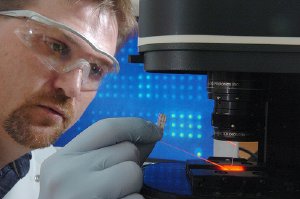Argonne biochemist Daniel Schabacker could be considered a Sherlock Holmes of bioterrorism. Although he doesn't carry around a pipe and magnifying glass as he attempts to nab the culprit, he has a far more powerful deductive tool: the biochip.
 Argonne biologist Dan Schabacker loads a biochip onto a reader for analysis.
Argonne biologist Dan Schabacker loads a biochip onto a reader for analysis.
The biochip offers Schabacker and his colleagues at Loyola University (Ill.) a chance to determine the "signatures" of weaponizable biological agents, most notably anthrax. While some scientists have used DNA analysis to identify the particular strain of anthrax, the biochips help scientists and government officials to learn how the anthrax was grown, narrowing the pool of potential suspects. This project, started only within the past couple of years, exemplifies the burgeoning field of microbial forensics.
"Microbial forensics is one of the biggest topics in counterterrorism today, and one of the biggest challenges in dealing with bioterrorism," Schabacker said. "The proteomic analysis that we're able to do with our biochips provides a new and different set of information about biological agents than we'd been able to see before; it can provide us with a complete fingerprint of the organism that we can then use to conclusively identify its origin."
According to Schabacker, DNA analysis represents nearly the entirety of the methodology that currently supports microbial forensics. "The problem with only using DNA analysis is that it only tells you what strain you are dealing with, and strains can be shared between multiple agencies or institutions. There can be a dozen labs that all share the same strain," he said. "The genetic material of the protein doesn't change based on how it grows, but the proteins do - and that information is incredibly important."
Because pathogen proteins hold an entirely separate kind of information, Schabacker believes that the two approaches pursued in concert could yield a comprehensive database of different anthrax cultures. "The ultimate goal of this project is for us to be able to build a library of signatures for all the common anthrax varieties," Schabacker said.
Developed in the early part of the decade originally as a diagnostic tool, a biochip consists of a one-centimeter by one-centimeter array that contains anywhere between several dozen and several hundred "dots," or small drops. Each of these drops contains a unique protein, antibody or nucleic acid that will attach to a particular reagent.
Scientists obtain the anthrax proteins to fill the wells through a process called fractionation. Essentially, the scientists break open the anthrax bacteria using chemicals and suck up the proteins. They then chop up the proteins and use another chemical process to separate out the individual protein fragments by their molecular weights.
This process creates hundreds of separate protein fractions, which are then arranged in a single biochip containing 96-well grids. Once the wells in the biochips are filled with protein fractions, scientists can then use different chemicals, or reagents, to test the microarrays just as a detective would dust for fingerprints. Just like an police interview with a suspect, this chemical process is known as "interrogation." When a reagent interacts with a particular protein fragment, that well will "light up," creating part of the protein signature.
Although the biochip technology has the potential to develop protein signatures of just about any biological agent, Schabacker and Loyola professor Adam Driks have devoted their initial focus initially to anthrax because it is relatively easily manufactured and dispersed.
"Anthrax is a pretty forgiving bacterium - it'll grow in a bunch of different conditions," Schabacker said. "It's probably the single most attractive pathogen of choice to terrorists who don't have a lot of really expensive equipment or expertise."
An expert on anthrax, Driks and his laboratory pioneered the forensic analysis of the spore coat of the bacterium. Schabacker combined the biochip technology with Eprogen's fractionation technology, providing a nexus that connects government research, academia and industry.
Helping scientists track down terrorists isn't the biochip's only use. Biochips have already shown promise in diagnostic medicine. After developing the biochip technology, Schabacker licensed it to several companies, including Eprogen, Inc. in Darien, Illinois and Akonni Biosystems in Frederick, Maryland. Instead of looking at anthrax, Eprogen has put biochips to use to look for common cancer biomarkers. That research could open the door for doctors to create "antibody profiles" that could help them design individualized drugs or treatment programs for patients.
The work Akonni has done focuses on identifying other pathogens - those not normally associated with terrorist activity. Soon, biochips may begin showing up in greater numbers in doctor's offices around the country, as they provide accurate and speedy diagnoses of a wide variety of infections, such as those caused by Multidrug-Resistant Tuberculosis (MDR-TB) and the often deadly Methicillin-resistant Staphylococcus aureus (MRSA).